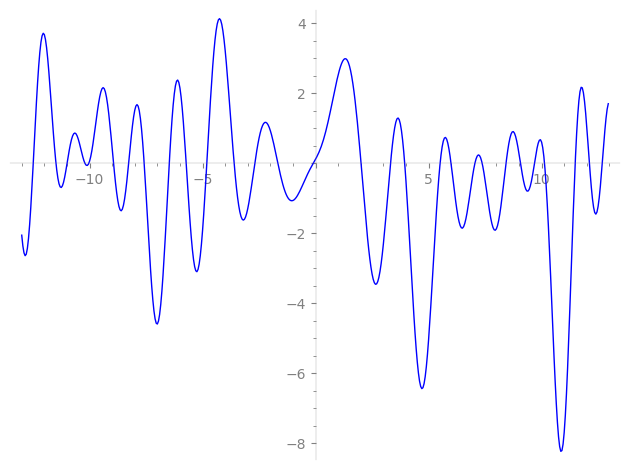| L(s) = 1 | + (−0.707 − 0.707i)2-s + (−0.707 − 0.707i)7-s + (−0.707 + 0.707i)8-s + i·9-s + (−0.5 − 0.866i)11-s + 1.00i·14-s + 1.00·16-s + (0.707 − 0.707i)18-s + (−0.258 + 0.965i)22-s + (−1.22 − 1.22i)23-s − 1.73·29-s + (−1.22 + 1.22i)37-s + (−0.707 + 0.707i)43-s + 1.73i·46-s + 1.00i·49-s + ⋯ |
| L(s) = 1 | + (−0.707 − 0.707i)2-s + (−0.707 − 0.707i)7-s + (−0.707 + 0.707i)8-s + i·9-s + (−0.5 − 0.866i)11-s + 1.00i·14-s + 1.00·16-s + (0.707 − 0.707i)18-s + (−0.258 + 0.965i)22-s + (−1.22 − 1.22i)23-s − 1.73·29-s + (−1.22 + 1.22i)37-s + (−0.707 + 0.707i)43-s + 1.73i·46-s + 1.00i·49-s + ⋯ |
\[\begin{aligned}\Lambda(s)=\mathstrut & 1925 ^{s/2} \, \Gamma_{\C}(s) \, L(s)\cr =\mathstrut & (-0.608 - 0.793i)\, \overline{\Lambda}(1-s) \end{aligned}\]
\[\begin{aligned}\Lambda(s)=\mathstrut & 1925 ^{s/2} \, \Gamma_{\C}(s) \, L(s)\cr =\mathstrut & (-0.608 - 0.793i)\, \overline{\Lambda}(1-s) \end{aligned}\]
Particular Values
| \(L(\frac{1}{2})\) |
\(\approx\) |
\(0.1194684255\) |
| \(L(\frac12)\) |
\(\approx\) |
\(0.1194684255\) |
| \(L(1)\) |
|
not available |
| \(L(1)\) |
|
not available |
\(L(s) = \displaystyle \prod_{p} F_p(p^{-s})^{-1} \)
| $p$ | $F_p(T)$ |
|---|
| bad | 5 | \( 1 \) |
| 7 | \( 1 + (0.707 + 0.707i)T \) |
| 11 | \( 1 + (0.5 + 0.866i)T \) |
| good | 2 | \( 1 + (0.707 + 0.707i)T + iT^{2} \) |
| 3 | \( 1 - iT^{2} \) |
| 13 | \( 1 + iT^{2} \) |
| 17 | \( 1 - iT^{2} \) |
| 19 | \( 1 - T^{2} \) |
| 23 | \( 1 + (1.22 + 1.22i)T + iT^{2} \) |
| 29 | \( 1 + 1.73T + T^{2} \) |
| 31 | \( 1 - T^{2} \) |
| 37 | \( 1 + (1.22 - 1.22i)T - iT^{2} \) |
| 41 | \( 1 + T^{2} \) |
| 43 | \( 1 + (0.707 - 0.707i)T - iT^{2} \) |
| 47 | \( 1 + iT^{2} \) |
| 53 | \( 1 + iT^{2} \) |
| 59 | \( 1 + T^{2} \) |
| 61 | \( 1 + T^{2} \) |
| 67 | \( 1 + (-1.22 + 1.22i)T - iT^{2} \) |
| 71 | \( 1 + T + T^{2} \) |
| 73 | \( 1 + iT^{2} \) |
| 79 | \( 1 + 1.73T + T^{2} \) |
| 83 | \( 1 + iT^{2} \) |
| 89 | \( 1 + T^{2} \) |
| 97 | \( 1 + iT^{2} \) |
| show more | |
| show less | |
\(L(s) = \displaystyle\prod_p \ \prod_{j=1}^{2} (1 - \alpha_{j,p}\, p^{-s})^{-1}\)
Imaginary part of the first few zeros on the critical line
−8.937413160832672828205657195167, −8.270163754974547660122480985402, −7.58314519156258640593756672012, −6.47242048375655178568754236577, −5.72419664130496760936268464042, −4.81206923411779520275639380938, −3.60224581623420799670860079948, −2.68764483924140092030201014520, −1.66675912390277921664476638977, −0.10323774396426775483792737637,
2.01228577952821758886545043971, 3.31675212690511534777902824405, 3.94295148761655084680918762609, 5.51034543517896651496282733433, 5.99352665611368500728085890719, 7.04924179633465435539268661114, 7.37068423544754272685901805327, 8.426281497757717237863479170911, 9.067846197837611036118047650922, 9.685186851915361262946685778992

